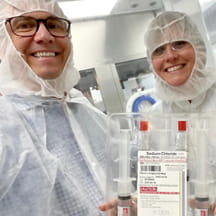The patient was prepped and sedated—ready to go. The medical team was set to administer a dose of Spinraza, a medication used to treat spinal muscular atrophy. But just prior to the injection, the medicine was inadvertently spilled on the floor. From a financial perspective, it was a costly error—Spinraza runs $125,000 per dose. But more importantly, there was no backup dose available.
"It's a very unfortunate situation," says Thomas Lausten, BPharm, MBA, RPh, director of pharmacy at Children's Hospital of Wisconsin in Milwaukee. "These patients and their families are desperate for these drugs. And while that mistake was somewhat of an anomaly, the fact is there's any number of situations where the drug could not be available when the patient needs it."
Ordinarily, Lausten says, the clinicians could order a replacement dose from the pharmacy's inventory. But because this medication was white bagged—distributed from a specialty pharmacy to the hospital for administration to a specific patient only—they had no choice but to cancel and reschedule the procedure.
Increased white bagging could hinder distribution systems
As drug prices rise and insurance providers aim to control costs, the white bagging practice is becoming more commonplace, according to Lausten. The National Association of Boards of Pharmacy cites one study that shows 28% of medical benefit drug volume is distributed via white bagging or brown bagging (dispensing of a medication from a pharmacy directly to a patient, who then transports it to the physician's office for administration).
Managing white bagged orders places added strain on hospital drug delivery systems, according to Lausten. He and his team at Children's Wisconsin have been able to manage so far because it's been limited to more seldomly used medications, but he fears that's changing.
"White bagging is becoming a crisis situation—it's a slippery slope," Lausten says. "We did it with Spinraza, but if we're forced to white bag something like Remicade (a medication used to treat children who have ulcerative colitis and moderate to severe active Crohn's disease), we're talking about thousands of patients, tens of thousands of doses. There's no distribution system out there to keep all that straight."
Patient safety chief among concerns
In addition to trying to manage white bagged medications within a hospital's existing drug distribution system, Lausten says the practice raises other concerns:
- Errors. Delivery delays and lost shipments are not uncommon, as are dosage errors. "If you can imagine a scenario where something could go wrong, we've probably experienced it," Lausten says.
- Waste. If a white bagged medication can't be used by the intended recipient—for any reason—the hospital isn't allowed to use that medicine for another patient, which can leave hundreds of thousands of dollars' worth of medication on the shelf. "I don't know how much money insurers are really saving themselves by doing this," Lausten says.
- Safety. When medications are not ready at the time patients need them, it can negatively impact patient outcomes. "It's becoming a significant patient safety issue," Lausten says.
Advice: communicate, stay ahead of white bagging
Some hospitals are renegotiating contracts with their pharmaceutical providers, in part to alleviate concerns over white bagging, according to Lausten. He says it's also critical to assess your organization to understand the impact white bagging may have financially and – most importantly – on patient safety.
"You need to be in conversations with the insurers and the large health plans upfront," Lausten says. "If you wait to see how it plays out and don't stay on top of it, you could quickly find yourself upside down."


